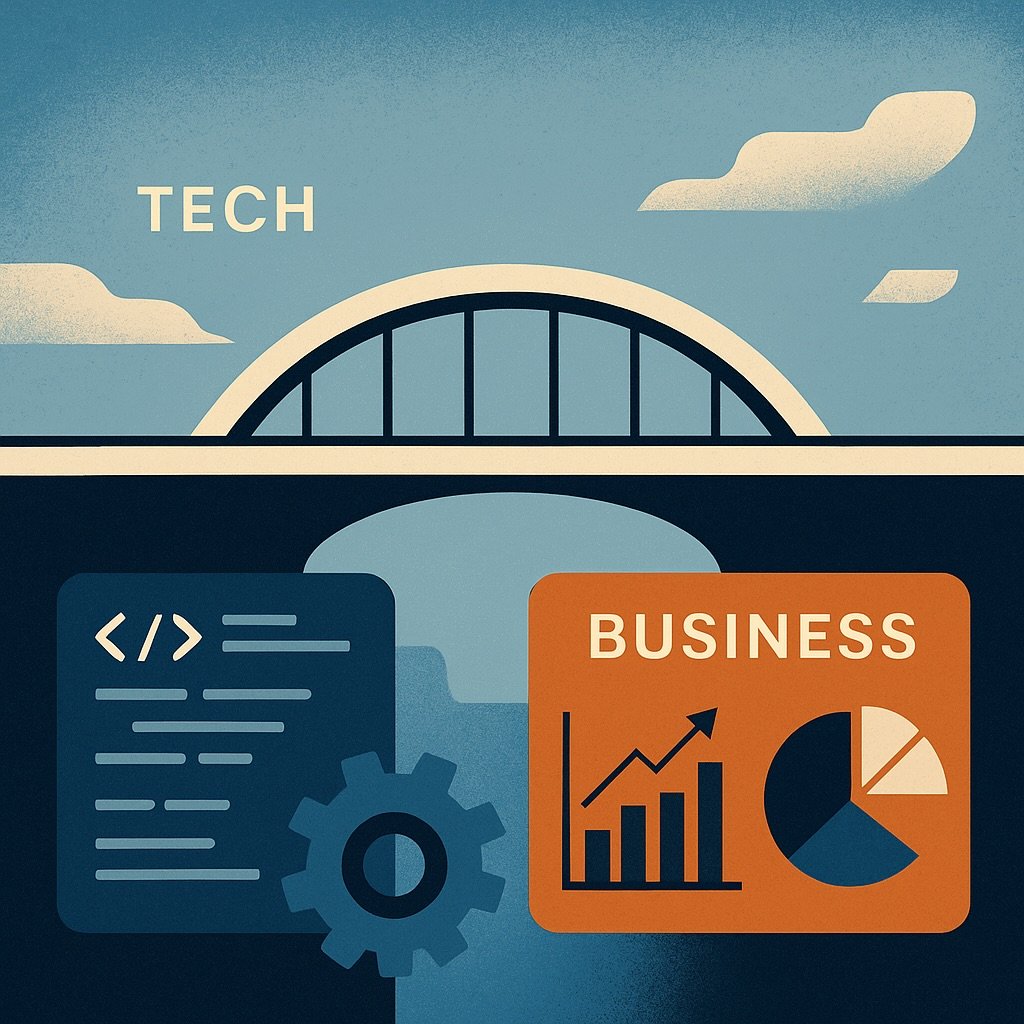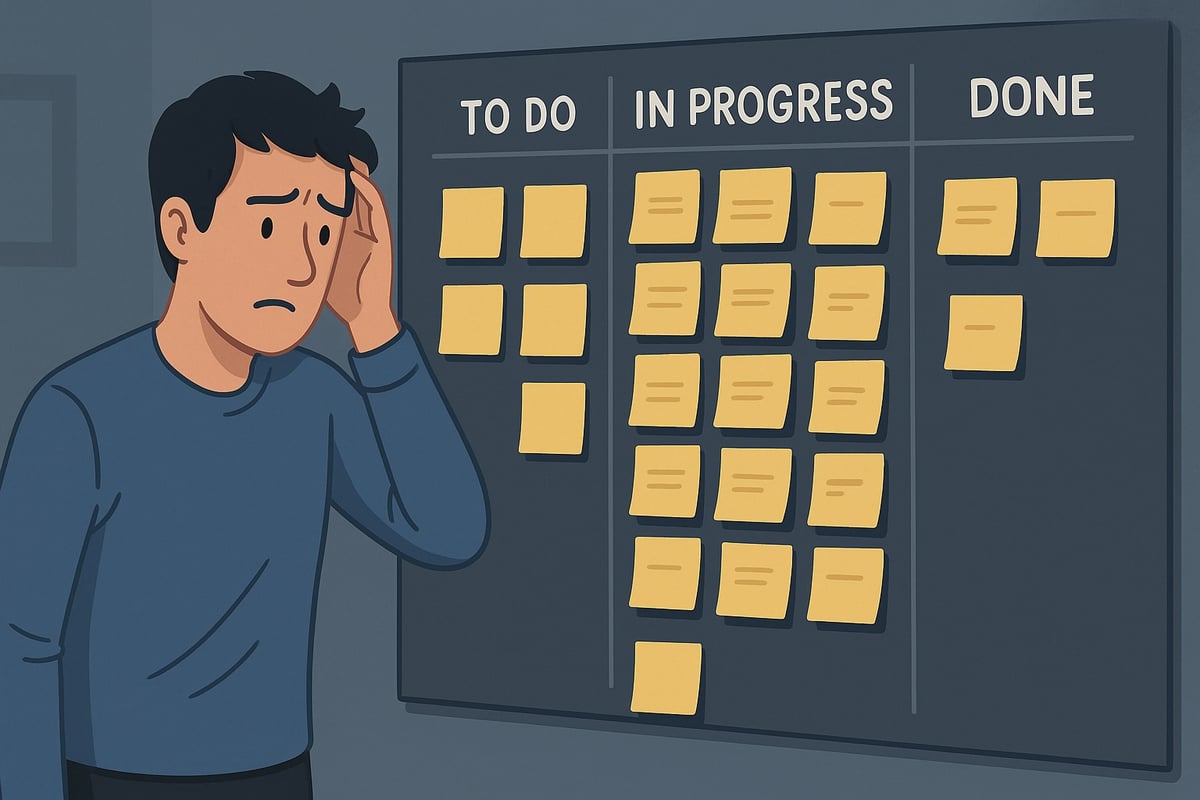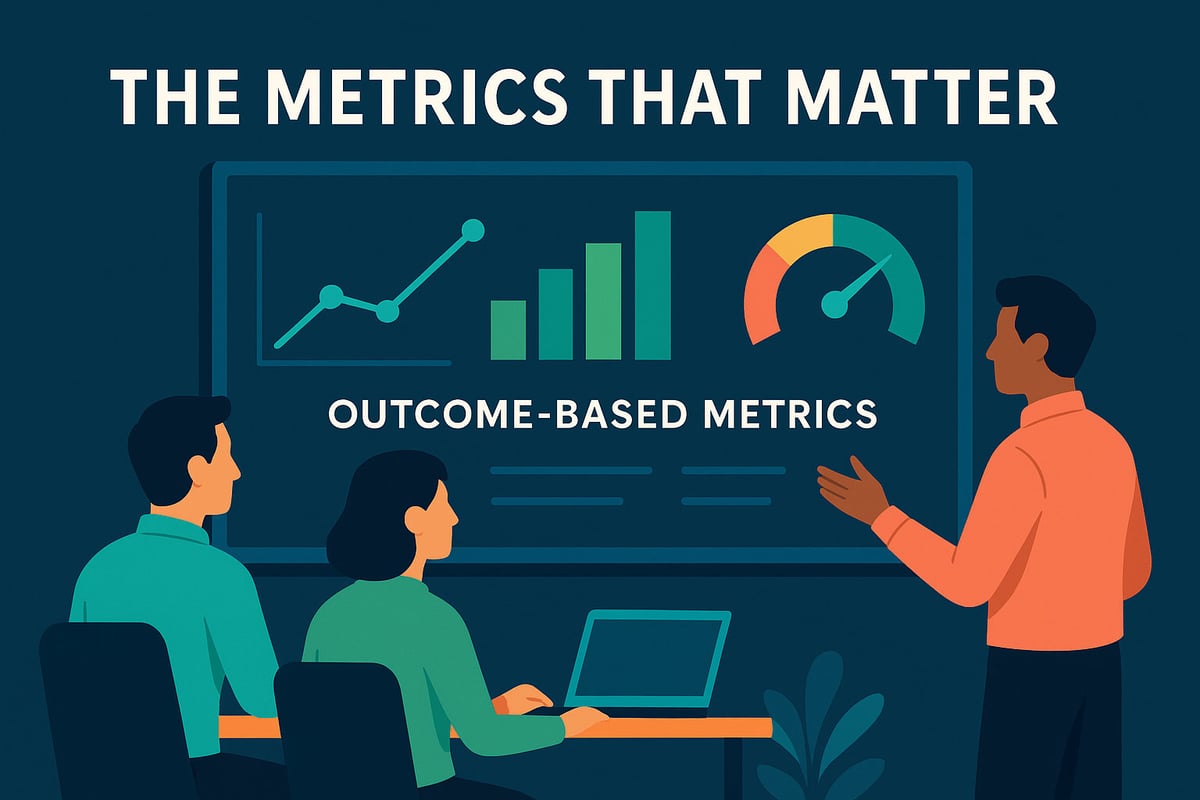As engineering leaders, we’re asked to bridge two seemingly distant worlds: the technical realm where our teams operate and the business landscape that our companies navigate. The uncomfortable truth? Most engineering strategies fail not because the technology is wrong, but because they’re disconnected from the business outcomes that actually matter. The gap between your technical roadmap and business impact isn’t just a communication problem, it’s an existential threat to your team’s relevance in the organization.
I’ve seen engineering leaders create elaborate technical visions that excite their teams but leave executives cold. I’ve also witnessed the opposite: leaders who focus exclusively on business metrics without a coherent technical strategy, leaving their teams confused and disengaged. Both approaches ultimately fail because they don’t connect the dots between technical decisions and business results.
Why Most Tech Roadmaps Fail to Deliver Impact
Traditional approaches to technology roadmapping suffer from a few critical flaws:
-
The Abstraction Trap: Too many roadmaps live in the realm of vague, aspirational statements that sound impressive but provide no practical guidance for decision-making.
-
The Technology-First Mindset: Engineers love solving technical problems, but when roadmaps focus primarily on technical elegance rather than business value, they often lead to sophisticated solutions that nobody actually needs.
-
The Execution Disconnect: Even well-crafted strategies often fail because there’s no clear path from high-level vision to day-to-day engineering work.
According to Will Larson at StaffEng, “Strategies are tools of proactive alignment that empower teams to move quickly and with confidence.” A good strategy doesn’t just set direction, it enables better, faster decisions at all levels of the organization.
The Strategic Planning Framework That Actually Works
Successful tech roadmaps aren’t created through a single, monolithic planning exercise. They emerge from a structured process that connects ground-level implementation details to higher-level business goals. This approach ensures alignment between technical initiatives and business outcomes while providing clear direction for engineering teams.
1. Start Where You Are: The “Five Documents” Approach
Rather than beginning with abstract vision statements, consider a pragmatic, bottom-up approach to strategic planning. This method starts with concrete design documents and technical decisions, then extracts patterns to form your broader strategy.
The process is straightforward: collect approximately five recent design documents or technical specifications your team has created. Analyze these documents to identify common themes, approaches, and principles. These recurring patterns form the foundation of your engineering strategy. To develop a longer-term vision, examine multiple strategic initiatives and project their evolution over the next two years.
This “working backward” method ensures your strategy is grounded in the reality of what your team is already building. Start by documenting specific technical decisions your team has recently made or needs to make. Look for patterns across these decisions, and you’ll find the core elements of your strategy.
The beauty of this approach is that it eliminates the paralysis that comes with trying to craft the perfect strategy from scratch. You’re not staring at a blank page, you’re synthesizing insights from work that’s already happening.
2. Connect Technical Work to Business Outcomes with OKRs
Once you’ve identified strategic themes from your design documents, the next step is explicitly connecting them to business outcomes using Objectives and Key Results (OKRs).
Effective engineering OKRs bridge technical initiatives and business goals:
- Objective: Accelerate feature delivery to improve customer retention
- Key Results:
- Reduce CI/CD pipeline execution time from 20 to 5 minutes
- Increase test automation coverage from 60% to 95% for core services
- Decrease production defect rate by 30%
Notice how these key results are both technically specific (your engineers understand exactly what to do) and business-aligned (executives can see why it matters). This dual nature is what makes OKRs powerful for bridging the gap.
3. Make Prioritization Transparent with the Impact-Effort Matrix
Engineering organizations always have more potential projects than capacity. The Impact-Effort Matrix provides a simple but powerful framework for making prioritization decisions transparent:
- Quick Wins (High Impact/Low Effort): Prioritize these for immediate gains
- Strategic Bets (High Impact/High Effort): Warrant significant investment with a long-term view
- Fill-ins (Low Impact/Low Effort): Do when resources allow
- Time Sinks (Low Impact/High Effort): Avoid or minimize
This framework forces the crucial conversations about business value versus technical complexity that often remain implicit. When a project is categorized as a “Strategic Bet,” everyone understands both the substantial investment required and the significant business impact expected.
According to Planview’s research, “By 2026, businesses will spend an estimated $1.4 trillion dollars due to the consequences of strategic drift.” Clear prioritization frameworks help prevent this drift by keeping teams focused on high-impact work.
Building a Complete Strategic Planning Process
A comprehensive strategic planning process involves five phases that connect business context to execution details:
Phase 1: Situational Analysis
Begin by understanding where you are today:
- Company: Assess your technical debt, current capabilities, and architecture
- Competitors: Benchmark against industry standards and competitors
- Customers: Understand user needs and pain points related to your technology
- Collaborators: Evaluate partnership opportunities and integration requirements
- Climate: Consider regulatory requirements, industry trends, and market conditions
This analysis provides essential context for your strategy. A thorough situational analysis involves examining both internal and external factors that impact your operations, including current technological landscape, market dynamics, and emerging industry trends. This foundation ensures your strategic planning is grounded in reality rather than aspirational thinking.
Phase 2: Define Strategic Direction
With a clear understanding of your current state, define where you want to go:
- Mission: The fundamental purpose of your engineering team
- Vision: A compelling, forward-looking picture (2-3 years out)
- Goals: Broad, high-level outcomes aligned with the vision
- Objectives: Specific, Measurable, Achievable, Relevant, and Time-bound (SMART) actions
A common mistake is making the vision too abstract or too ambitious. Will Larson advises keeping vision documents concise (1-2 pages), specific, and “optimistic rather than audacious… what you could accomplish if every project is finished on time and without major setbacks.”
Phase 3: Strategy Formulation
Develop concrete strategies and operational tactics to achieve your defined objectives:
- Identify the unique sequence of steps needed
- Establish guiding principles and policies
- Define key performance indicators (KPIs)
- Create detailed roadmaps with dependencies and milestones
Effective roadmaps often use a 70-20-10 resource allocation rule: 70% sustaining current systems, 20% for incremental improvements, and 10% for innovative/disruptive technology. This balance ensures you’re maintaining current operations while still creating space for innovation.
Phase 4: Implementation Planning
Create detailed action plans outlining:
- Required resources (budget, personnel, time)
- Responsibilities and accountability
- Risk mitigation strategies
- Any governance frameworks
Jellyfish emphasizes the importance of balancing predictability with delivery risk mitigation: “Set and track goals, triage blockers, understand and manage project or deliverable progress to enable on-time delivery.”
Phase 5: Monitoring and Adaptation
Continuously track progress against KPIs and metrics, providing feedback and adjusting the plan as needed:
- Output Monitoring: Cycle time, pipeline success rates
- Outcome Monitoring: Feature adoption rates, user satisfaction
- Impact Monitoring: Revenue attribution, cost savings, efficiency gains
This isn’t about bureaucratic reporting—it’s about creating short feedback loops that allow you to learn and adapt. As PyArtez notes, “Strategic plans should be periodically reviewed against progress and key performance indicators (KPIs). This allows early detection of any gaps between planned and actual performance, enabling swift corrective action.”
Bridging the Strategy-Execution Gap
Even the best strategy is worthless if it doesn’t influence day-to-day work. Here are three practices that help bridge this gap:
1. Make Strategic Decisions Explicit
Document key technical decisions and their business rationale in a centralized, accessible location. Architecture Decision Records (ADRs) provide a lightweight template for capturing:
- The context behind a decision
- The options considered
- The chosen approach and its justification
- The business impact expected
When decisions are explicit and accessible, teams can make consistent choices that align with the broader strategy.
2. Connect Daily Work to Strategic Goals
Engineers need to understand how their daily tasks contribute to larger goals. Try these techniques:
- Tag user stories and tasks with the strategic objectives they support
- Start stand-up or sprint planning meetings by reviewing progress against key strategic metrics
- Celebrate wins that directly advance strategic goals
Teams perform better when they understand “impact and context” – “Do our ICs and teams have context for why they are working on projects? Can we trace individuals’ direct impact on key business initiatives?”
3. Establish Clear Feedback Loops
Creating a feedback system that connects technical work to business outcomes is essential:
- Define leading indicators that predict business impact
- Implement dashboards that visualize progress on both technical and business metrics
- Schedule regular reviews to assess strategy effectiveness and make adjustments
The goal is to create a virtuous cycle where technical decisions are continuously informed by their observed business impact.
Pitfalls to Avoid in Engineering Strategic Planning
Even the most well-designed strategic planning processes can struggle without proper attention to common challenges. Strategic planning is as much about avoiding mistakes as it is about making the right choices. By recognizing these potential pitfalls early, engineering leaders can take proactive steps to ensure their roadmaps deliver the intended business impact.
Below are some common pitfalls that engineering leaders should avoid:
-
Lack of Clarity: Make sure everyone on the team clearly understands the strategic plan. Concrete, specific statements foster true alignment, while vague statements only create an illusion of agreement.
-
Ignoring External Environment: Stay aware of market trends and technological advancements that might invalidate your assumptions.
-
Rigid Plans: Maintain flexibility to adapt to unforeseen changes. Your roadmap should be a living document, not a straight jacket.
-
Inadequate Communication: Effectively communicate the strategic plan to all stakeholders, using different vocabulary and emphasis for different audiences.
-
Ignoring Risk Management: Consider potential risks and develop mitigation strategies for each major initiative.
Measuring Success: Engineering Metrics That Matter
Effective engineering leaders establish comprehensive measurement frameworks that connect technical activities to business outcomes. Research across high-performing engineering organizations reveals several key metrics categories that consistently demonstrate business impact:
- Engineering Investment Analysis: Where teams are investing time and resources
- Delivery Efficiency: Speed, throughput, and quality balance
- Predictability: On-time delivery and commitment fulfillment
- Team Health: Developer engagement, focus, and growth
- Financial Impact: Development costs, ROI, and budget forecasting
The most effective metric systems connect technical indicators (like deployment frequency) to business outcomes (like revenue growth or customer satisfaction). For a deeper dive into engineering metrics that resonate with executives, see my previous post on Metrics That Matter: Translating Engineering Performance for the C-Suite.
Taking the First Step
If you’re looking to implement a more effective strategic planning process in your engineering organization, start with these actions:
- Document recent technical decisions using the “Five Documents” approach to extract strategic patterns
- Connect your technical initiatives to business objectives using OKRs or similar frameworks
- Create a prioritization matrix to make trade-off decisions transparent
- Establish metrics that trace the path from technical output to business impact
- Schedule regular reviews to assess both progress and the continued relevance of your strategy
Remember, the goal isn’t to create the perfect roadmap on your first attempt. The power of this approach is that it evolves through continuous learning and adaptation, becoming more refined with each cycle.
Conclusion
A successful tech roadmap isn’t just about picking the right technologies, it’s about creating a clear path from technical decisions to business outcomes, with appropriate metrics and feedback mechanisms to guide the journey. By adopting structured approaches to strategic planning, engineering leaders can ensure their teams’ efforts contribute directly to the organization’s success.
The frameworks and processes outlined here help bridge the perpetual gap between technical work and business impact. When executed well, they enable engineering teams to move faster with greater confidence, knowing their work is aligned with what truly matters to the business.
What strategic planning approaches have you found most effective in your organization? I’d love to hear your experiences in creating tech roadmaps that deliver real business impact.








